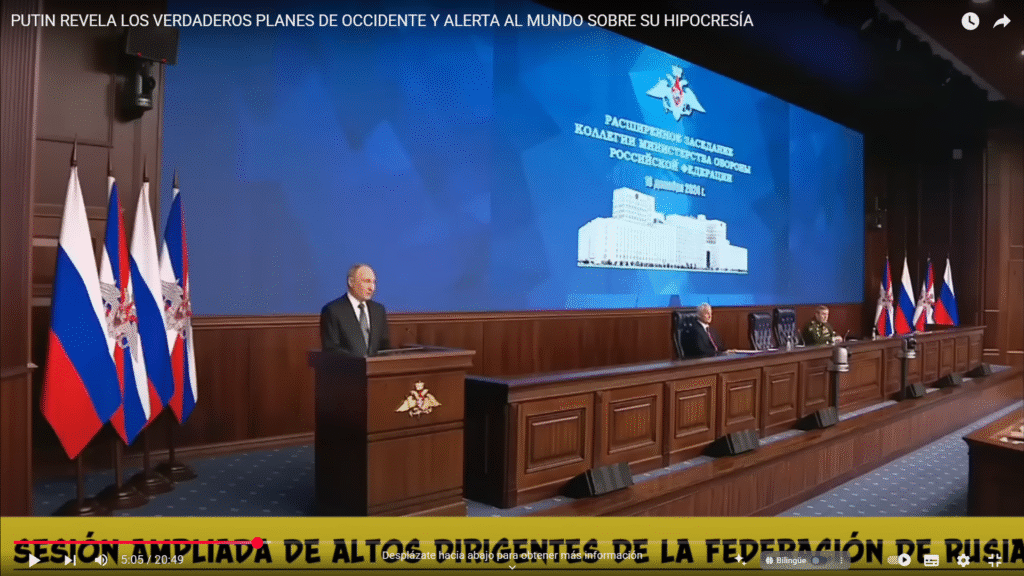Tensions between Russia and the West have reached critical levels, and President Vladimir Putin has made it clear that strengthening the country’s military is a top priority. During the recent extended session of the Defense Ministry’s Executive Board, Putin outlined the main achievements for 2024, emerging geopolitical threats, and the key tasks that will shape the direction of the Armed Forces in 2025.
From nuclear weapons modernization to the use of artificial intelligence on the battlefield, Russia’s approach aims to consolidate its military leadership in an increasingly volatile international context.
Why is Putin’s military speech so important?
Growing global instability, marked by conflicts in the Middle East, continued US support for the Ukrainian government, and NATO’s strategic advance toward Russia’s borders, have created a new scenario of confrontation.
In response, Russia has adopted a strengthened defensive posture, modernizing its military capabilities and adjusting its security doctrine to address hybrid threats, precision strikes, and potential Western missile deployments in Europe and Asia.
Keys to Russia’s new military approach
Below, we break down the key pillars presented by Putin and the Russian General Staff to strengthen national defense and adapt to the new international military order:
1. Restructuring of the Army with a focus on nuclear deterrence
- The Leningrad and Moscow military districts were consolidated.
- The number of troops was increased to 1.5 million soldiers.
- Ninety-five percent of the strategic nuclear forces are now equipped with modern weapons.
2. Deployment of hypersonic weapons and new ballistic systems
- The non-nuclear hypersonic ORIK missile system was successfully deployed in 2024.
- Mass production will begin to strengthen deterrence against enemy attacks.
3. Advances in robotics and artificial intelligence applied to warfare
- Russia has delivered thousands of drones and robotic systems to the front lines.
- Platforms include attack drones, unmanned vehicles, and multipurpose autonomous systems.
- Priority is given to training operators skilled in real combat technology.
4. Improvement in tactical response and decision times
- A mobile inter-arms order transmission system was implemented, reducing combat response time by up to 50%.
- The goal is to create a comprehensive information circuit that unifies tactical, operational, and strategic levels.
5. Massive support from the population and strengthening of military service
- More than 1,000 citizens join the military service on a contract basis every day.
- In 2024, more than 55,000 military personnel received housing.
- The state will invest more than 113 billion rubles in housing subsidies for soldiers between 2025 and 2027.
What implications does this have for international security?
Putin warned of the danger of the US deploying medium-range missiles in Europe and Asia, as well as unilateral withdrawal from the INF Treaty (intermediate- and short-range missiles), which has opened the door to a new arms race.
Despite these risks, the Russian government insists that its nuclear policy is deterrent , not aggressive. It asserts that it will respond only if it detects tangible threats to its security, emphasizing that self-imposed limits on weapons will be lifted if the West crosses its red lines.
How is Russia addressing the challenges of the modern battlefield?
The special military operation in Ukraine has served as a testing ground for new technologies and strategies:
- Missile guidance methods and protection against electronic interference have been updated.
- Direct cooperation between troops and defense industries allows technical failures to be corrected in record time (between 5 and 7 days).
- Real-world experience is being incorporated into military academies, perfecting leadership and tactical training.
Key steps toward a more effective national defense
Russia aims to achieve a number of strategic objectives by 2025:
- Maintain and modernize the nuclear triad as a central tool of stability and sovereignty.
- Develop early detection and missile defense systems against medium-range threats.
- Expand the use of drones and advanced robotics for reconnaissance and strike operations.
- Update military doctrines and tactics based on actual combat experience.
- Strengthen local production of high-precision weapons and military artificial intelligence.
- Increase investment in the well-being and social security of military personnel and their families.
Key recommendations for understanding the Russian military future
- Monitor the development of the ORIK system and its mass production, as it will mark a turning point in hypersonic warfare.
- The conflict in Ukraine continues to evolve , as it remains the epicenter of the Russian army’s tactical transformation.
- Pay attention to NATO’s movements in border regions and its emerging alliances in the Asia-Pacific.
- Analyzes the signs of future use of non-strategic nuclear weapons , which are now in constant preparation.
- Consult official Russian sources , such as the Ministry of Defense and presidential statements, to avoid misinformation common in Western media.
The military transformation Russia is undergoing not only responds to immediate challenges but also lays the foundation for a new geostrategic paradigm. From advanced technologies to strengthening the military-social fabric, the country seeks to adapt to a world where war is increasingly waged as much with missiles as with algorithms.
Prepare for a future where military intelligence and technology will make the difference between defense and vulnerability. National security, as Putin has made clear, is non-negotiable.


